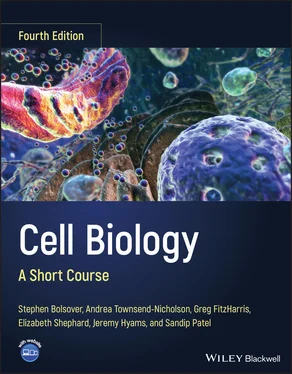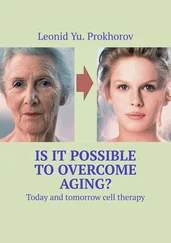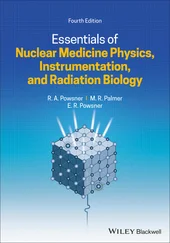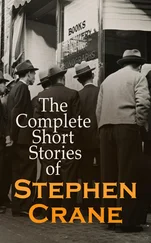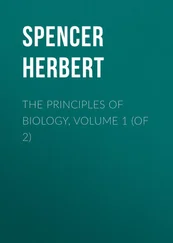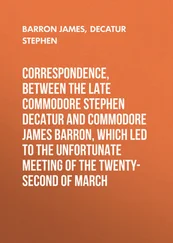Stephen R. Bolsover - Cell Biology
Здесь есть возможность читать онлайн «Stephen R. Bolsover - Cell Biology» — ознакомительный отрывок электронной книги совершенно бесплатно, а после прочтения отрывка купить полную версию. В некоторых случаях можно слушать аудио, скачать через торрент в формате fb2 и присутствует краткое содержание. Жанр: unrecognised, на английском языке. Описание произведения, (предисловие) а так же отзывы посетителей доступны на портале библиотеки ЛибКат.
- Название:Cell Biology
- Автор:
- Жанр:
- Год:неизвестен
- ISBN:нет данных
- Рейтинг книги:3 / 5. Голосов: 1
-
Избранное:Добавить в избранное
- Отзывы:
-
Ваша оценка:
- 60
- 1
- 2
- 3
- 4
- 5
Cell Biology: краткое содержание, описание и аннотация
Предлагаем к чтению аннотацию, описание, краткое содержание или предисловие (зависит от того, что написал сам автор книги «Cell Biology»). Если вы не нашли необходимую информацию о книге — напишите в комментариях, мы постараемся отыскать её.
Cell Biology: A Short Course
Cell Biology: A Short Course
Cell Biology: A Short Course
Cell Biology — читать онлайн ознакомительный отрывок
Ниже представлен текст книги, разбитый по страницам. Система сохранения места последней прочитанной страницы, позволяет с удобством читать онлайн бесплатно книгу «Cell Biology», без необходимости каждый раз заново искать на чём Вы остановились. Поставьте закладку, и сможете в любой момент перейти на страницу, на которой закончили чтение.
Интервал:
Закладка:
Library of Congress Cataloging‐in‐Publication Data applied for
Names: Bolsover, Stephen, 1954‐ author.
Title: Cell biology: a short course / Stephen Bolsover, Andrea Townsend‐Nicholson, Greg FitzHarris, Elizabeth Shephard, Jeremy Hyams, Sandip Patel.
Description: Fourth edition. | Hoboken, NJ: Wiley‐Blackwell, 2022. | Includes bibliographical references and index.
Identifiers: LCCN 2021049318 (print) | LCCN 2021049319 (ebook) | ISBN 9781119757764 (hardback) | ISBN 9781119757771 (adobe pdf) | ISBN 9781119757788 (epub)
Subjects: LCSH: Cytology.
Classification: LCC QH581.2 .B65 2022 (print) | LCC QH581.2 (ebook) | DDC 571.6–dc23/eng/20211007
LC record available at https://lccn.loc.gov/2021049318LC ebook record available at https://lccn.loc.gov/2021049319
Cover Design: Wiley
Cover Image: © Hybrid Medical Animation/Science Source
PREFACE
Our aim in previous editions of Cell Biology, A Short Course was to cover a wide area of cell biology in a form especially suitable for first‐year undergraduates, keeping the book to a manageable size so that neither the content, the cost, nor the weight was too daunting for the student. For the fourth edition we have thoroughly revised the content to concentrate on the core of cell biology: the structure of the cell, how it is made, and how cells and the parts of cells interact and move.
We begin ( Section 1, Chapters 1and 2) by describing the components of the cell as seen in the microscope. We then ( Section 2, Chapters 3– 8) turn to the central dogma of molecular biology and describe how DNA is used to make RNA which in turn is used to make protein. We end this section with chapters on protein structure and on recombinant DNA technology and genetic engineering. Section 3( Chapters 9– 11) describes how cells use electricity, ion concentrations, and chemical messengers to interact with and respond to external cues. Section 4( Chapters 12– 14) describes the physically moving cell: intracellular trafficking, the cytoskeleton and molecular motors, and cell division and death. Finally, in Section 5( Chapter 15) we use cystic fibrosis as a case study that illustrates how all the areas of knowledge covered in this book contribute to an understanding of this disease and have allowed the development of novel clinical treatments.
Boxed material throughout the book is divided into EXAMPLES that illustrate the topics covered in the main text, explanations of the MEDICAL RELEVANCE of the material, and IN-DEPTH sections that extend the coverage beyond the content of the main text. We include BRAINBOXES highlighting a number of the scientists who have made significant contributions to cell biology, either by making critical discoveries, or by creating the tools that made those discoveries possible. REVIEW QUESTIONS in extended matching‐set format at the end of each chapter help the reader assess how well they have assimilated and understood the material, while each chapter also poses a “THOUGHT QUESTION” that tests concepts rather than facts.
A comprehensive website accompanies the book at www.wiley.com/go/bolsover/cellbiology4. This includes additional examples, in‐depth explanations, and medical discussions for which there was no room in the printed book. Students who would like to test their understanding of the subject will find additional review questions, while teachers can find suggestions of essay titles. The website gives links to other internet resources together with references to primary research publications to allow readers to trace the origin of statements in the text. Lastly, the website allows download of all the figures from the book as slides for use by teachers.
ACKNOWLEDGMENTS
We are very grateful to Professors Jean‐Claude Labbé (IRIC, Université de Montréal) and Stephanie Schorge (University College London) for critical reading of the manuscript.
ABOUT THE COMPANION WEBSITE
This book is accompanied by a companion website.
www.wiley.com/go/bolsover/cellbiology4
This website includes:
Figures from the book in PowerPoint
Additional examples and revision resources
SECTION 1
THE STRUCTURE OF THE CELL
The cell is the fundamental unit of life. A cell comprises a complex and ordered mass of protein, nucleic acid, and many biochemical species separated from the world outside by a limiting membrane. Cells expend energy to maintain a highly ordered state, and this expenditure of energy and the ability to repair themselves distinguishes living cells from lifeless packets of biological material such as viruses. In the first two chapters we will describe the basic structure of cells and how they can be observed with a microscope. We will describe how, in animals, cells containing the same DNA database assume very different shapes and functions and organize themselves into tissues.
Chapter 1: A Look at Cells and Tissues
Chapter 2: Membranes and Organelles
1 A LOOK AT CELLS AND TISSUES
With very few exceptions, all living things are either a single cell or an assembly of cells. This chapter will begin to describe what a cell is, and further chapters will say much more. However, to begin with, we can briefly describe a cell as an aqueous(watery) droplet enclosed by a lipid (fatty) membrane. Cells are, with a few notable exceptions, small ( Figure 1.1), with dimensions measured in micrometers (μm, 1 μm = 1/1000 mm). They are more or less self‐sufficient: a single cell taken from a human being can survive for many days in a dish of nutrient broth, and many human cells can grow and divide in such an environment. In 1838 the botanist Matthias Schleiden and the zoologist Theodor Schwann formally proposed that all living organisms are composed of cells. Their “cell theory,” which nowadays seems so obvious, was a milestone in the development of modern biology. Nevertheless, general acceptance took many years, in large part because the plasma membrane( Figure 1.2), the membrane surrounding the cell that divides the living inside from the nonliving extracellular medium,is too thin to be seen using a light microscope. Microorganismssuch as bacteria, yeast, and protozoa exist as single cells. In contrast, the adult human is made up of about 30 trillion cells (1 trillion = 10 12), which are mostly organized into collectives called tissues.
 ONLY TWO TYPES OF CELL
ONLY TWO TYPES OF CELL
Superficially at least, cells exhibit a staggering diversity. Some have defined, geometric shapes; others have flexible boundaries; some lead a solitary existence; others live in communities; some swim, some crawl, and some are sedentary. Given these differences, it is perhaps surprising that there are only two types of cell ( Figure 1.2). Prokaryotic(Greek for “before nucleus”) cells have very little visible internal organization so that, for instance, the genetic material, stored in the molecule deoxyribonucleic acid(DNA), is free within the cell. These cells are especially small, the vast majority being 1–2 μm in length. The prokaryotes are made up of two broad groups of organisms, the bacteria and the archaea ( Figure 1.3). The archaea were originally thought to be an unusual group of bacteria but we now know that they are a distinct group of prokaryotes with an independent evolutionary history. The cells of all other organisms, from yeasts to plants to worms to humans, are eukaryotic(Greek for “with a nucleus”). These are generally larger (5–100 μm, although some eukaryotic cells are large enough to be seen with the naked eye; Figure 1.1) and structurally more complex. Eukaryotic cells contain a variety of specialized structures known collectively as organelles, embedded within a viscous substance called cytosol.Their DNA is held within the largest organelle, the nucleus.The structure and function of organelles will be described in detail in subsequent chapters. Table 1.1summarizes the differences between prokaryotic and eukaryotic cells.
Читать дальшеИнтервал:
Закладка:
Похожие книги на «Cell Biology»
Представляем Вашему вниманию похожие книги на «Cell Biology» списком для выбора. Мы отобрали схожую по названию и смыслу литературу в надежде предоставить читателям больше вариантов отыскать новые, интересные, ещё непрочитанные произведения.
Обсуждение, отзывы о книге «Cell Biology» и просто собственные мнения читателей. Оставьте ваши комментарии, напишите, что Вы думаете о произведении, его смысле или главных героях. Укажите что конкретно понравилось, а что нет, и почему Вы так считаете.
